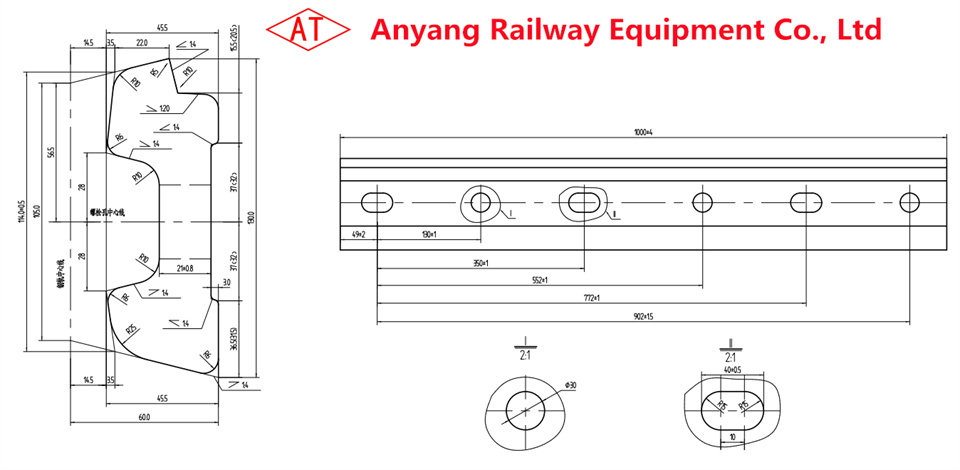History of Butt Fasteners and Fishplates for Russian Railway Rail
Jan 19, 2022
Butt fasteners are made in the form of flat plates connecting the rails with bolts. At the beginning of the 20th century, from the previously used four-hole flat linings, they switched to six-hole apron linings, in which the sole of the rail is overlapped by a horizontal shelf that turns into a vertical "apron". At the place where the rails are attached to the butt sleepers, cutouts are made in the shelf and apron to place linings and crutches (against the second and fifth bolt holes). With increasing loads and speeds, oblique fractures appeared in this weakened section.
Since 1947, Russian railways have been switching to two-headed linings with four bolt holes for rails P75 and P65 and six bolt holes for rails P50. The weight of four—pin pads for rails P50 is 18.77 kg, for rails P65 and P75 — 23.48 kg, and six-pin pads for rails P50 - 18.77 kg, for rails P65 and P75 - 29.5 kg. In the equalizing spans of the jointless track, pads with six holes are used. The holes in the pads are made alternately oval and round. The upper and lower heads of the pads have a bevel made at the same angle as the lower face of the head and the upper face of the sole of the rail. Therefore, when tightening the butt bolts, the stability of the rail joint is ensured. Butt bolts with a diameter of 27 mm for rails P65 and P75 and 24 mm for rails P50 have a round head and an oval headrest. Such a headrest enters the oval hole of the lining, so that the bolt does not turn when screwing the nut. Split washers, put on the bolt under the nut, provide elastic perception of forces up to 12 kN. For insulating joints on lines equipped with automatic locking, wooden linings were used initially, later lignofolium linings.

Since the 1950s - metal ones. A polyethylene gasket is placed between the metal plate and the rail, polyethylene bushings are put on the bolts. The ends of the rails are also separated by an insulating gasket. In the design of the insulating joint, enclosing pads covering the rails from the side of the lower plane of the sole can also be used.
Since 1969, glue-bolted electrical insulating joints have been widely used, in which the two-headed pads are reduced in height on both sides by 3 mm. The backlash formed between the lining and the rail will be filled with fiberglass impregnated with epoxy glue with the addition of a hardener. When using linings with six bolt holes and tightening bolts up to 150-170 kN, such a joint elastically perceives longitudinal forces up to 1500 kN, and when using enclosing linings - up to 3000 kN.
Anyang Railway Equipment Co., Ltd is professional manufacturer of P65 Rail Fishplates and fasteners for Russian railway.
Technical featurers of P65 Rail Fishplates with 6 holes:
Since 1947, Russian railways have been switching to two-headed linings with four bolt holes for rails P75 and P65 and six bolt holes for rails P50. The weight of four—pin pads for rails P50 is 18.77 kg, for rails P65 and P75 — 23.48 kg, and six-pin pads for rails P50 - 18.77 kg, for rails P65 and P75 - 29.5 kg. In the equalizing spans of the jointless track, pads with six holes are used. The holes in the pads are made alternately oval and round. The upper and lower heads of the pads have a bevel made at the same angle as the lower face of the head and the upper face of the sole of the rail. Therefore, when tightening the butt bolts, the stability of the rail joint is ensured. Butt bolts with a diameter of 27 mm for rails P65 and P75 and 24 mm for rails P50 have a round head and an oval headrest. Such a headrest enters the oval hole of the lining, so that the bolt does not turn when screwing the nut. Split washers, put on the bolt under the nut, provide elastic perception of forces up to 12 kN. For insulating joints on lines equipped with automatic locking, wooden linings were used initially, later lignofolium linings.

Since the 1950s - metal ones. A polyethylene gasket is placed between the metal plate and the rail, polyethylene bushings are put on the bolts. The ends of the rails are also separated by an insulating gasket. In the design of the insulating joint, enclosing pads covering the rails from the side of the lower plane of the sole can also be used.
Since 1969, glue-bolted electrical insulating joints have been widely used, in which the two-headed pads are reduced in height on both sides by 3 mm. The backlash formed between the lining and the rail will be filled with fiberglass impregnated with epoxy glue with the addition of a hardener. When using linings with six bolt holes and tightening bolts up to 150-170 kN, such a joint elastically perceives longitudinal forces up to 1500 kN, and when using enclosing linings - up to 3000 kN.
Anyang Railway Equipment Co., Ltd is professional manufacturer of P65 Rail Fishplates and fasteners for Russian railway.
Technical featurers of P65 Rail Fishplates with 6 holes:
- It is Hot Forged from Rolled Steel Material: 55#
- Type: P65, 6 holes
- Matches Standard: GOST 33184-2014
- Size, mm: 1000x130x45.5
- Cross sectional area, cm2: 38,45
- Number of hole x size, pcs x mm: 3pcs x diameter 30, 3pcs x 40mm x 30mm
- Weight of clamps, kg: 29.5
- Quantity of clamps in 1 ton, pcs: 34pcs
- Production Standard: TB/T 2345-2008 Technical Specifications for the Procurements of 43kg/m~75kg/m as Joint Bar

